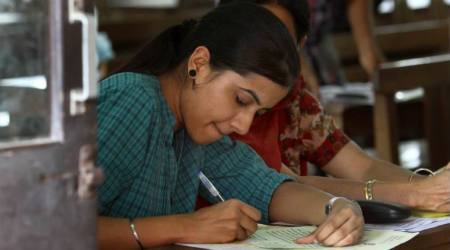 At a school in Gurgaon last week, after the declaration of class XII results. Ten thousand students crossed 95% this year, and 63,000 over 90%. Express Photo by Manoj Kumar
At a school in Gurgaon last week, after the declaration of class XII results. Ten thousand students crossed 95% this year, and 63,000 over 90%. Express Photo by Manoj Kumar
Ashok Kumar Pandey noticed something odd about CBSE’s class XII results in 2006. “If I recall correctly, this was the first time I felt there was something wrong. Many students had scored 99 in English, Hindi, political science and history. People had started asking questions,” says Pandey, principal of Ahlcon International School in east Delhi for 22 years now.
In five years, his suspicion grew into belief. “It was evident that the board was inflating marks.” But there was no evidence to back this. Until 2013.
The practice of ‘grade inflation’ was first highlighted in 2013 by two bloggers, Debarghya Das and Prashant Bhattacharji, who mined ISC and CBSE results, respectively, to show both boards resorted to this. According to Das, grade inflation, like regular inflation, is when the same absolute grade, say a 90, is worth less than it was before because more people were given that grade. “Over time, as it becomes easier and easier to score a 95, it becomes harder distinguish amongst top students,” he says. Read | Half of all 95s in CBSE English in Delhi’s private schools: Data. Click here
His analysis (see figure 1A) shows that in CBSE, a 95 per cent aggregate is 21 times as prevalent today as it was in 2004, and a 90 per cent close to nine times as prevalent. In the ISC Board (figure 2A), a 95 per cent is almost twice as prevalent today as it was five years ago. “What was a great grade back in the day is no more a great grade today,” says the 24-year-old engineer, a Cornell University alumnus currently working on machine learning in New York.
Although no board has admitted “spiking” marks, the widespread view is that it is done in the garb of ‘moderation’, a common practice adopted by boards to “bring uniformity in the evaluation process”. In other words, scores are tweaked to align marking standards of different examiners, maintain parity in pass percentage across years, and compensate students for getting a relatively tough paper in a multiple-paper set-up. Read | Dropped out years ago, these women clear Class X exams. Click here
“Moderation has a scientific basis, but it is being handled unscientifically by school boards. Boards should award no more than five marks to compensate students. But last year, for instance, CBSE awarded up to 10 marks extra to all students in some subjects. This is unacceptable,” says former CBSE chairman Ashok Ganguly.

Ashok Thakur, former higher education secretary to the government, suspects grade inflation turned rampant after the HRD ministry decided to give 40 per cent weightage to an engineering aspirant’s class XII marks for admission to the NITs. “We wanted kids to focus on their school education. But the decision did not have the desired effect. Instead, all school boards started awarding marks indiscriminately to give their students an edge during admissions to the NITs and other engineering institutions that used JEE (Main) score,” Thakur told The Indian Express.
An analysis by a nine-member government committee in 2015 (figure 4; ‘The State Boards’) corroborates Thakur’s view. The average marks awarded by state and national boards increased over three years from 2013 to 2015. “It is clear that for several boards… the averages have increased over years. This might have some students believe that their boards are becoming lenient with time (with a perception that it might be to help their candidates in the JEE [Main]),” the report states. According to Das’s analysis of CBSE results (figure 1B), too, the sharpest increase in students scoring 90 per cent and above in science was between 2013 and 2015.
Grade inflation has forced top universities to set the eligibility bar drastically high — like the 100 per cent cutoff at Shri Ram College of Commerce in 2011.
The absurdity forced CBSE to call a meeting of all 40 school boards this year to urge them to discontinue “artifical spiking of marks”. CBSE decided to lead by example and promised not to inflate its results.
But although the 2017 results have seen a small correction, the board has clearly not discarded the practice completely, says Das. Almost 6.5 per cent of mathematics examinees in 2017 scored 95 or more — 10 times higher than in 2004 — and almost 6 per cent of physics examinees scored 95 or more, 35 times more than in 2004
“Under regular inflation, prices can rise without limit. However, because grades are capped at A or A+, grade inflation results in a greater concentration of students at the top of the distribution. This compression of grades diminishes their value as an indicator of student abilities. Without grade inflation, a truly outstanding student might be awarded an A, while a very good student might receive a B+. With grade inflation, both students receive As, making it hard for employers and graduate schools to differentiate them,” explains Das.
Rajat Moona, IIT-Bhilai director, agrees: “Board results, in a way, have lost their relevance. An examination is suppose to act as a differentiator. If the trend of grade inflation is not reversed then soon board results will be dumped as a criterion for admission by almost all higher education institutions.”

